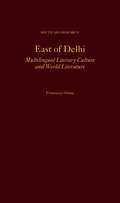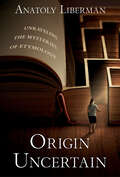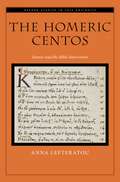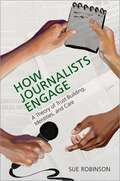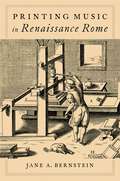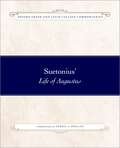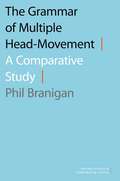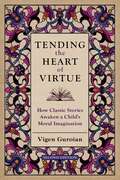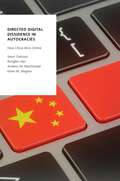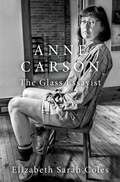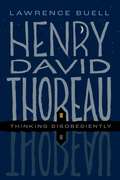- Table View
- List View
East of Delhi: Multilingual Literary Culture and World Literature (South Asia Research)
by Francesca OrsiniLike many societies across the world, the region of Awadh in North India has been bilingual throughout its history. But literary histories of the region often indicate otherwise. In the early twentieth century, colonists recodified literary histories separately according to language, detached written literature from oral literature, and reimagined the entangled literary past according to their own ideas about language, literature, and Indian history. At the same time, multilingualism remained resilient and acquired new uses. East of Delhi: Multilingual Literary Culture and World Literature examines literature produced, practiced, and circulated in and out of North India, focusing on the region of Awadh, from the beginning of recorded vernacular literature in the late fourteenth century to the colonial era of the early twentieth century. This book considers texts in a wide range of genres-courtly, devotional, and popular-composed in the main languages of the region: Hindavi, Persian, Brajbhasha, Urdu. Individual chapters focus on narratives, devotional song-poems and didactic works, local courtly literary practices, and multilingual education as recorded in biographical dictionaries-anthologies. Author Francesca Orsini suggests that this multilingual and multi-genre approach is better suited to capturing the texture, complexity, and dynamics of literature in the world, and of literary history, than approaches that focus only on global circulation or models that draw centers and peripheries on a single global map.
East of Delhi: Multilingual Literary Culture and World Literature (South Asia Research)
by Francesca OrsiniLike many societies across the world, the region of Awadh in North India has been bilingual throughout its history. But literary histories of the region often indicate otherwise. In the early twentieth century, colonists recodified literary histories separately according to language, detached written literature from oral literature, and reimagined the entangled literary past according to their own ideas about language, literature, and Indian history. At the same time, multilingualism remained resilient and acquired new uses. East of Delhi: Multilingual Literary Culture and World Literature examines literature produced, practiced, and circulated in and out of North India, focusing on the region of Awadh, from the beginning of recorded vernacular literature in the late fourteenth century to the colonial era of the early twentieth century. This book considers texts in a wide range of genres-courtly, devotional, and popular-composed in the main languages of the region: Hindavi, Persian, Brajbhasha, Urdu. Individual chapters focus on narratives, devotional song-poems and didactic works, local courtly literary practices, and multilingual education as recorded in biographical dictionaries-anthologies. Author Francesca Orsini suggests that this multilingual and multi-genre approach is better suited to capturing the texture, complexity, and dynamics of literature in the world, and of literary history, than approaches that focus only on global circulation or models that draw centers and peripheries on a single global map.
Hegel's Phenomenology of Spirit: A Guide (OXFORD GUIDES TO PHILOSOPHY SERIES)
by Terry PinkardHegel's Phenomenology of Spirit has a long-standing reputation as one of the key books in the history of Western philosophy, but many are unsure just what it is about. Even the words in the title are disputed: What sense of "phenomenology" is being used? Is Geist to be rendered "spirit" or "mind"? What does this have to do with Hegel's original title, "The Science of the Experience of Consciousness"? To add to the perplexity, Hegel developed his own technical vocabulary in writing the book, but the jargon he created never caught on and thus there is no common usage for it. As a consequence, both the beginner and the Hegel specialist must make key decisions about to understand many basic terms in the book. This Oxford Guide walks the reader through this canonical text paragraph-by-paragraph using accessible and approachable language, such that both students and instructors--whether they come from philosophy, political theory, literature, or history backgrounds--will benefit.
Hegel's Phenomenology of Spirit: A Guide (OXFORD GUIDES TO PHILOSOPHY SERIES)
by Terry PinkardHegel's Phenomenology of Spirit has a long-standing reputation as one of the key books in the history of Western philosophy, but many are unsure just what it is about. Even the words in the title are disputed: What sense of "phenomenology" is being used? Is Geist to be rendered "spirit" or "mind"? What does this have to do with Hegel's original title, "The Science of the Experience of Consciousness"? To add to the perplexity, Hegel developed his own technical vocabulary in writing the book, but the jargon he created never caught on and thus there is no common usage for it. As a consequence, both the beginner and the Hegel specialist must make key decisions about to understand many basic terms in the book. This Oxford Guide walks the reader through this canonical text paragraph-by-paragraph using accessible and approachable language, such that both students and instructors--whether they come from philosophy, political theory, literature, or history backgrounds--will benefit.
No Professor's Lectures Can Save Us: William James's Pragmatism, Radical Empiricism, and Pluralism
by John J. StuhrIn No Professor's Lectures Can Save Us, John J. Stuhr utilizes the thought of American philosopher and psychologist William James to develop an original world view that addresses both enduring philosophical problems and contemporary cultural issues. Drawing on and illuminating the entirety of James's work, Stuhr explores James's psychology, his account of religious experience and his "will to believe" thesis, his pragmatism, his radical empiricism, his pluralism, and his writing on politics, democracy, and imperialism. Throughout, Stuhr engages the wide-ranging scholarship on James's philosophy and explores connections between James and the work of Bergson, Deleuze, Dewey, Peirce, Rorty, and Whitehead, as well as intellectual movements including contemporary democratic theory, positive psychology, and philosophical naturalism. After establishing the need to approach James's writings as intimately interwoven, Stuhr turns to each of James's major texts, including The Will to Believe, Principles of Psychology, Varieties of Religious Experience, Pragmatism, The Meaning of Truth, and Essays in Radical Empiricism. His focus throughout is practical, showing the concrete differences it makes in one's life should one take up a broadly Jamesian perspective across the "ever not quite" endeavors of our finite lives. "From this unsparing practical ordeal," James noted, "no professor's lectures and no array of books can save us." In this spirit, this book does not by itself, promise salvation. Instead, it is a master class not only in the philosophy of William James but in a new philosophy through James's thought.
No Professor's Lectures Can Save Us: William James's Pragmatism, Radical Empiricism, and Pluralism
by John J. StuhrIn No Professor's Lectures Can Save Us, John J. Stuhr utilizes the thought of American philosopher and psychologist William James to develop an original world view that addresses both enduring philosophical problems and contemporary cultural issues. Drawing on and illuminating the entirety of James's work, Stuhr explores James's psychology, his account of religious experience and his "will to believe" thesis, his pragmatism, his radical empiricism, his pluralism, and his writing on politics, democracy, and imperialism. Throughout, Stuhr engages the wide-ranging scholarship on James's philosophy and explores connections between James and the work of Bergson, Deleuze, Dewey, Peirce, Rorty, and Whitehead, as well as intellectual movements including contemporary democratic theory, positive psychology, and philosophical naturalism. After establishing the need to approach James's writings as intimately interwoven, Stuhr turns to each of James's major texts, including The Will to Believe, Principles of Psychology, Varieties of Religious Experience, Pragmatism, The Meaning of Truth, and Essays in Radical Empiricism. His focus throughout is practical, showing the concrete differences it makes in one's life should one take up a broadly Jamesian perspective across the "ever not quite" endeavors of our finite lives. "From this unsparing practical ordeal," James noted, "no professor's lectures and no array of books can save us." In this spirit, this book does not by itself, promise salvation. Instead, it is a master class not only in the philosophy of William James but in a new philosophy through James's thought.
Origin Uncertain: Unraveling the Mysteries of Etymology
by Anatoly LibermanLost origins of words revealed. We like to recount that goodbye started out as "god be with you," that whiskey comes from the Gaelic for "water of life," or that avocado originated as the Aztec word for "testicle." But there are many words with origins unknown, disputed, or so buried in old journals that they may as well be lost to the general public. In Origin Uncertain: Unraveling the Mysteries of Etymology, eminent etymologist Anatoly Liberman draws on his professional expertise and etymological database to tell the stories of less understood words such as nerd, fake, ain't, hitchhike, trash, curmudgeon, and quiz, as well as puzzling idioms like kick the bucket and pay through the nose. By casting a net so broadly, the book addresses language history, language usage (including grammar), history (both ancient and modern), religion, superstitions, and material culture. Writing in the spirit of adventure through the annals of word origins, Liberman also shows how historical linguists construct etymologies, how to evaluate competing explanations, and how to pursue further research.
Origin Uncertain: Unraveling the Mysteries of Etymology
by Anatoly LibermanLost origins of words revealed. We like to recount that goodbye started out as "god be with you," that whiskey comes from the Gaelic for "water of life," or that avocado originated as the Aztec word for "testicle." But there are many words with origins unknown, disputed, or so buried in old journals that they may as well be lost to the general public. In Origin Uncertain: Unraveling the Mysteries of Etymology, eminent etymologist Anatoly Liberman draws on his professional expertise and etymological database to tell the stories of less understood words such as nerd, fake, ain't, hitchhike, trash, curmudgeon, and quiz, as well as puzzling idioms like kick the bucket and pay through the nose. By casting a net so broadly, the book addresses language history, language usage (including grammar), history (both ancient and modern), religion, superstitions, and material culture. Writing in the spirit of adventure through the annals of word origins, Liberman also shows how historical linguists construct etymologies, how to evaluate competing explanations, and how to pursue further research.
The Homeric Centos: Homer and the Bible Interwoven (OXFORD STUDIES IN LATE ANTIQUITY SERIES)
by Anna LefteratouThe Homeric Centos, a poem that is Homeric in style and biblical in theme, is a dramatic illustration of the creative cultural and religious dialogue between Classical Antiquity and Christianity taking place in the Roman Empire during the fifth century CE. The text is attributed to Eudocia, empress and poet, who died in exile in the Holy Land ca. 460. With lines drawn verbatim from Homer's Iliad and Odyssey, the poem begins with the Creation and Fall and ends with Jesus' Resurrection and Ascension. In this blend of Homeric style and Christian themes, there are also echoes of Classical and classicising literature, stretching from Homer and drama to imperial literature. Equally prominent are echoes of earlier Christian canonical and apocryphal works, verse models, and theological works. In The Homeric Centos: Homer and the Bible Interwoven, Anna Lefteratou analyzes the double inspiration of the poem by both classical and Christian traditions. This book explores the works relationship with the cultural milieu of the fifth century CE and offers in-depth analysis of the scenes of Creation and Fall, and Jesus' Passion, Resurrection, and Ascension. This book exposes the work's debt to centuries of Homeric reception and interpretation as well as Christian literature and exegesis, and places it at the crossroads of Christian and pagan literary traditions.
The Homeric Centos: Homer and the Bible Interwoven (OXFORD STUDIES IN LATE ANTIQUITY SERIES)
by Anna LefteratouThe Homeric Centos, a poem that is Homeric in style and biblical in theme, is a dramatic illustration of the creative cultural and religious dialogue between Classical Antiquity and Christianity taking place in the Roman Empire during the fifth century CE. The text is attributed to Eudocia, empress and poet, who died in exile in the Holy Land ca. 460. With lines drawn verbatim from Homer's Iliad and Odyssey, the poem begins with the Creation and Fall and ends with Jesus' Resurrection and Ascension. In this blend of Homeric style and Christian themes, there are also echoes of Classical and classicising literature, stretching from Homer and drama to imperial literature. Equally prominent are echoes of earlier Christian canonical and apocryphal works, verse models, and theological works. In The Homeric Centos: Homer and the Bible Interwoven, Anna Lefteratou analyzes the double inspiration of the poem by both classical and Christian traditions. This book explores the works relationship with the cultural milieu of the fifth century CE and offers in-depth analysis of the scenes of Creation and Fall, and Jesus' Passion, Resurrection, and Ascension. This book exposes the work's debt to centuries of Homeric reception and interpretation as well as Christian literature and exegesis, and places it at the crossroads of Christian and pagan literary traditions.
How Journalists Engage: A Theory of Trust Building, Identities, and Care
by Sue RobinsonA unique theory of trust building in engagement journalism that proposes journalists move to an ethic of care as they prioritize listening and learning within communities instead of propping up problematic institutions. In How Journalists Engage, Sue Robinson explores how journalists of different identities, especially racial, enact trusting relationships with their audiences. Drawing from case studies, community-work, interviews, and focus groups, she documents a growing built environment around trust building and engagement journalism that represents the first major paradigm shift of the press's core values in more than a century. As Robinson shows, journalists are being trained to take on new roles and skillsets around listening and learning, in addition to normative routines related to being a watchdog and storyteller. She demonstrates how this movement mobilizes the nurturing of personal, organizational, and institutional relationships that people have with information, sources, news brands, journalists, and each other. Developing a new theory of trust building, Robinson calls for journalists to grapple actively with their own identities--especially the privileges, biases, and marginalization attached to them--and those of their communities, resulting in a more intentional and effective moral voice focused on justice and equity through the news practice of an ethic of care.
How Journalists Engage: A Theory of Trust Building, Identities, and Care
by Sue RobinsonA unique theory of trust building in engagement journalism that proposes journalists move to an ethic of care as they prioritize listening and learning within communities instead of propping up problematic institutions. In How Journalists Engage, Sue Robinson explores how journalists of different identities, especially racial, enact trusting relationships with their audiences. Drawing from case studies, community-work, interviews, and focus groups, she documents a growing built environment around trust building and engagement journalism that represents the first major paradigm shift of the press's core values in more than a century. As Robinson shows, journalists are being trained to take on new roles and skillsets around listening and learning, in addition to normative routines related to being a watchdog and storyteller. She demonstrates how this movement mobilizes the nurturing of personal, organizational, and institutional relationships that people have with information, sources, news brands, journalists, and each other. Developing a new theory of trust building, Robinson calls for journalists to grapple actively with their own identities--especially the privileges, biases, and marginalization attached to them--and those of their communities, resulting in a more intentional and effective moral voice focused on justice and equity through the news practice of an ethic of care.
Printing Music in Renaissance Rome
by Jane A. BernsteinIn sixteenth-century Italy, Rome ranked second only to Venice as an important center for music book production. Throughout the century, printers in the Eternal City experimented more readily and more consistently with the materiality of the book than their Venetian counterparts, who, by standardizing their printing methods, came to dominate the international marketplace. The Romans' ingenuity and willingness to meet individual clients' needs resulted in music editions in a broader array of shapes and sizes, employing a wider range of printing techniques. They became "boutique" printers, eschewing the run-of-the-mill in favor of tailoring production to varied market demands. Accommodating the diverse requirements of their clientele, they supplied customized volumes, which Venetian presses either could not--or would not--produce. In Printing Music in Renaissance Rome, author Jane A. Bernstein offers a panoramic view of the cultures of music and the book in Rome from the beginning of printing in 1476 through the early seventeenth century. Emphasizing the exceptionalism of Roman music publishing, she highlights the innovative printing technologies and book forms devised by Roman bookmen. She also analyzes the Church's predominant influence on the book industry and, in turn, the Roman press's impact on such important composers as Palestrina, Marenzio, Victoria, and Cavalieri. Drawing on innovative publications, Bernstein reveals a synergistic relationship between music repertories and the materiality of the book. In particular, she focuses on the post-Tridentine period, when musical idioms, both new and old, challenged printers to employ alternative printing methods and modes of book presentation in the creation of their music editions. Of interest to musicologists, art historians, and book historians alike, this book builds on Bernstein's previous work as she continues to chart the course of music and the book in Renaissance Italy.
Printing Music in Renaissance Rome
by Jane A. BernsteinIn sixteenth-century Italy, Rome ranked second only to Venice as an important center for music book production. Throughout the century, printers in the Eternal City experimented more readily and more consistently with the materiality of the book than their Venetian counterparts, who, by standardizing their printing methods, came to dominate the international marketplace. The Romans' ingenuity and willingness to meet individual clients' needs resulted in music editions in a broader array of shapes and sizes, employing a wider range of printing techniques. They became "boutique" printers, eschewing the run-of-the-mill in favor of tailoring production to varied market demands. Accommodating the diverse requirements of their clientele, they supplied customized volumes, which Venetian presses either could not--or would not--produce. In Printing Music in Renaissance Rome, author Jane A. Bernstein offers a panoramic view of the cultures of music and the book in Rome from the beginning of printing in 1476 through the early seventeenth century. Emphasizing the exceptionalism of Roman music publishing, she highlights the innovative printing technologies and book forms devised by Roman bookmen. She also analyzes the Church's predominant influence on the book industry and, in turn, the Roman press's impact on such important composers as Palestrina, Marenzio, Victoria, and Cavalieri. Drawing on innovative publications, Bernstein reveals a synergistic relationship between music repertories and the materiality of the book. In particular, she focuses on the post-Tridentine period, when musical idioms, both new and old, challenged printers to employ alternative printing methods and modes of book presentation in the creation of their music editions. Of interest to musicologists, art historians, and book historians alike, this book builds on Bernstein's previous work as she continues to chart the course of music and the book in Renaissance Italy.
Suetonius' Life of Augustus (OXF GREEK LATIN COLLEGE COMMENT SERIES)
by Darryl A. PhillipsThe lifetime of Augustus (63 BCE -14 CE) was a key moment of transition for the Roman world. Following decades of civil war, the traditional government of the Roman Republic evolved to include a leading role for Augustus. Peace at home was balanced with wars of expansion and consolidation on the frontiers. Literature and the arts flourished. A building boom transformed the city of Rome. Augustus was at the center of it all, and thus the lifetime of Augustus and the life of Augustus himself have attracted keen interest from antiquity up to the present day. In his biography of Augustus, the early second century CE author C. Suetonius Tranquillus offers not only a survey of the major political, military and civic accomplishments of his subject, but also includes such diverse topics as Augustus's family lineage, spouses, personal appearance, leisure activities, intellectual pursuits and style of living. We find in the Life of Augustus a detailed biography of a leading figure at a pivotal historical moment, as well as the material for political, social, and cultural history that offers a wide range of approaches to the Augustan age. This volume provides a comprehensive edition of Suetonius's Life of Augustus for readers of Latin at the intermediate and advanced levels. The complete Latin text is presented, accompanied on the same page by a running vocabulary, grammatical support, and historical notes to aid comprehension, making this volume ideally suited for use on its own. An introduction to Suetonius and his style of biographical writing provides context for interpreting the text.
Suetonius' Life of Augustus (OXF GREEK LATIN COLLEGE COMMENT SERIES)
by Darryl A. PhillipsThe lifetime of Augustus (63 BCE -14 CE) was a key moment of transition for the Roman world. Following decades of civil war, the traditional government of the Roman Republic evolved to include a leading role for Augustus. Peace at home was balanced with wars of expansion and consolidation on the frontiers. Literature and the arts flourished. A building boom transformed the city of Rome. Augustus was at the center of it all, and thus the lifetime of Augustus and the life of Augustus himself have attracted keen interest from antiquity up to the present day. In his biography of Augustus, the early second century CE author C. Suetonius Tranquillus offers not only a survey of the major political, military and civic accomplishments of his subject, but also includes such diverse topics as Augustus's family lineage, spouses, personal appearance, leisure activities, intellectual pursuits and style of living. We find in the Life of Augustus a detailed biography of a leading figure at a pivotal historical moment, as well as the material for political, social, and cultural history that offers a wide range of approaches to the Augustan age. This volume provides a comprehensive edition of Suetonius's Life of Augustus for readers of Latin at the intermediate and advanced levels. The complete Latin text is presented, accompanied on the same page by a running vocabulary, grammatical support, and historical notes to aid comprehension, making this volume ideally suited for use on its own. An introduction to Suetonius and his style of biographical writing provides context for interpreting the text.
The Grammar of Multiple Head-Movement: A Comparative Study (OXFORD STUDIES COMPARATIVE SYNTAX SERIES)
by Phil BraniganHead-movement has played a central role in morpho-syntactic theory, but its nature has remained unclear. While it is widely accepted that the main grammatical constraint controlling head-movement is the Head Movement Constraint (HMC), this constraint is flouted in many of the linguistic structures examined in this book. More specifically, the strictures of the HMC turn out to be sometimes inactive for specific grammars allowing multiple head-movement to take place in particular syntactic contexts. In The Grammar of Multiple Head-Movement, Phil Branigan shows that multiple head-movement is far from rare, forming a part of the grammar in Finnish, in English, in Perenakan Javanese, in northern Norwegian and Swedish dialects, and generally in the Slavic and Algonquian language families. Basing his analysis on a new model of the grammatical parameters which control word formation in the human brain, Branigan shows how careful attention to the contexts in which multiple head-movement takes place allows new generalizations to be identified. And these, in turn, allow a new model to be formulated of how head-movement fits into the overall architecture of grammatical computation. Through careful comparative study, Branigan not only provides a better understanding of head-movement, but also provides new opportunities to address larger questions concerning the architecture of the grammatical system and the theory of linguistic parameters. A new account of how complex words are formed in languages as different as Russian or Innu-aimun, as well as in English, this study deepens our understanding of how languages vary and of the mental computational system of human grammars.
The Grammar of Multiple Head-Movement: A Comparative Study (OXFORD STUDIES COMPARATIVE SYNTAX SERIES)
by Phil BraniganHead-movement has played a central role in morpho-syntactic theory, but its nature has remained unclear. While it is widely accepted that the main grammatical constraint controlling head-movement is the Head Movement Constraint (HMC), this constraint is flouted in many of the linguistic structures examined in this book. More specifically, the strictures of the HMC turn out to be sometimes inactive for specific grammars allowing multiple head-movement to take place in particular syntactic contexts. In The Grammar of Multiple Head-Movement, Phil Branigan shows that multiple head-movement is far from rare, forming a part of the grammar in Finnish, in English, in Perenakan Javanese, in northern Norwegian and Swedish dialects, and generally in the Slavic and Algonquian language families. Basing his analysis on a new model of the grammatical parameters which control word formation in the human brain, Branigan shows how careful attention to the contexts in which multiple head-movement takes place allows new generalizations to be identified. And these, in turn, allow a new model to be formulated of how head-movement fits into the overall architecture of grammatical computation. Through careful comparative study, Branigan not only provides a better understanding of head-movement, but also provides new opportunities to address larger questions concerning the architecture of the grammatical system and the theory of linguistic parameters. A new account of how complex words are formed in languages as different as Russian or Innu-aimun, as well as in English, this study deepens our understanding of how languages vary and of the mental computational system of human grammars.
Tending the Heart of Virtue: How Classic Stories Awaken a Child's Moral Imagination
by Vigen GuroianFrom Pinocchio to The Chronicles of Narnia to Charlotte's Web, classic children's tales have shaped generations of young people. In recent years, homeschoolers and new classical schools have put these masterpieces of children's literature at the center of their curricula. And these stories continue to be embraced by parents, students, and educators alike. In Tending the Heart of Virtue, Vigen Guroian illuminates the power of classic tales and their impact on the moral imagination. He demonstrates how these stories teach the virtues through vivid depictions of the struggle between good and evil, while he also unveils components of the good, the true, and the beautiful in plot and character. With clarity and elegance, Guroian reads deeply into the classic stories. He demonstrates how these stories challenge and enliven the moral imaginations of children. And he shows the reader how to get "inside" of classic stories and communicate their lessons to the child. For more than two decades Tending the Heart of Virtue has been embraced by parents, guardians, and teachers for whom the stories it discusses are not only beloved classics but repositories of moral wisdom. This revised and expanded second edition includes three new chapters in which Guroian inteprets such stories as Hans Christian Andersen's The Ugly Duckling, the Grimms' Cinderella, and John Ruskin's The King of the Golden River. The concluding bibliographicsal essay has also been expanded.
Tending the Heart of Virtue: How Classic Stories Awaken a Child's Moral Imagination
by Vigen GuroianFrom Pinocchio to The Chronicles of Narnia to Charlotte's Web, classic children's tales have shaped generations of young people. In recent years, homeschoolers and new classical schools have put these masterpieces of children's literature at the center of their curricula. And these stories continue to be embraced by parents, students, and educators alike. In Tending the Heart of Virtue, Vigen Guroian illuminates the power of classic tales and their impact on the moral imagination. He demonstrates how these stories teach the virtues through vivid depictions of the struggle between good and evil, while he also unveils components of the good, the true, and the beautiful in plot and character. With clarity and elegance, Guroian reads deeply into the classic stories. He demonstrates how these stories challenge and enliven the moral imaginations of children. And he shows the reader how to get "inside" of classic stories and communicate their lessons to the child. For more than two decades Tending the Heart of Virtue has been embraced by parents, guardians, and teachers for whom the stories it discusses are not only beloved classics but repositories of moral wisdom. This revised and expanded second edition includes three new chapters in which Guroian inteprets such stories as Hans Christian Andersen's The Ugly Duckling, the Grimms' Cinderella, and John Ruskin's The King of the Golden River. The concluding bibliographicsal essay has also been expanded.
Directed Digital Dissidence in Autocracies: How China Wins Online (Oxford Studies in Digital Politics)
by Jason Gainous Rongbin Han Andrew W. MacDonald Kevin M. WagnerDoes the Internet fundamentally change the flow of politically relevant information, even in authoritarian regimes? If so, does it alter the attitudes and behavior of citizens? While there is a fair amount of research exploring how social media has empowered social actors to challenge authoritarian regimes, there is much less addressing whether and how the state can actively shape the flow of information to its advantage. In China, for instance, citizens often resort to "rightful resistance" to lodge complaints and defend rights. By using the rhetoric of the central government, powerless citizens may exploit the slim political opportunity structure and negotiate with the state for better governance. But this tactic also reinforces the legitimacy of authoritarian states; citizens engage rightful resistance precisely because they trust the state, at least the central government, to some degree. Drawing on original survey data and rich qualitative sources, Directed Digital Dissidence in Autocracies explores how authoritarian regimes employ the Internet in advantageous ways to direct the flow of online information. The authors argue that the central Chinese government successfully directs citizen dissent toward local government through critical information that the central government places online--a strategy that the authors call "directed digital dissidence". In this context, citizens engage in low-level protest toward the local government, and thereby feel empowered, while the central government avoids overthrow. Consequently, the Internet functions to discipline local state agents and to project a benevolent image of the central government and the regime as a whole. With an in-depth look at the COVID-19 and Xinjiang Cotton cases, the authors demonstrate how the Chinese state employs directed digital dissidence and discuss the impact and limitations of China's information strategy.
Directed Digital Dissidence in Autocracies: How China Wins Online (Oxford Studies in Digital Politics)
by Jason Gainous Rongbin Han Andrew W. MacDonald Kevin M. WagnerDoes the Internet fundamentally change the flow of politically relevant information, even in authoritarian regimes? If so, does it alter the attitudes and behavior of citizens? While there is a fair amount of research exploring how social media has empowered social actors to challenge authoritarian regimes, there is much less addressing whether and how the state can actively shape the flow of information to its advantage. In China, for instance, citizens often resort to "rightful resistance" to lodge complaints and defend rights. By using the rhetoric of the central government, powerless citizens may exploit the slim political opportunity structure and negotiate with the state for better governance. But this tactic also reinforces the legitimacy of authoritarian states; citizens engage rightful resistance precisely because they trust the state, at least the central government, to some degree. Drawing on original survey data and rich qualitative sources, Directed Digital Dissidence in Autocracies explores how authoritarian regimes employ the Internet in advantageous ways to direct the flow of online information. The authors argue that the central Chinese government successfully directs citizen dissent toward local government through critical information that the central government places online--a strategy that the authors call "directed digital dissidence". In this context, citizens engage in low-level protest toward the local government, and thereby feel empowered, while the central government avoids overthrow. Consequently, the Internet functions to discipline local state agents and to project a benevolent image of the central government and the regime as a whole. With an in-depth look at the COVID-19 and Xinjiang Cotton cases, the authors demonstrate how the Chinese state employs directed digital dissidence and discuss the impact and limitations of China's information strategy.
Anne Carson: The Glass Essayist
by Elizabeth Sarah ColesThe scholar is transparent and accountable, the poet inward and errant: anyone who reads Anne Carson has to suspend many such separations of power. The first monographic study of her work to date, Anne Carson: The Glass Essayist makes the case for the acclaimed poet, classicist, and translator as a remarkable experimental scholar and reader, who rehearses scholarly methods while slipping their constraints of form and emotion. Carson's attention to sources-ancient and modern, textual or visual-is one of few constants across almost four decades of her published writing, whose uncertain claims on discipline and genre are claimed here as a certain interpretive style. The book follows Carson's readings through variations in form-from early academic prose and poem-essays to creative adaptations and works for performance-to come to grips with what Coles calls Carson's transparency: not her easiness or literalism, but a taste for the exposure of her presence, process, and intent. Carson's portraits of working perform to readers even where she fantasizes her own erasure; where chance, poetic economy, impersonation, and imitation ride the line of anonymity. Coles situates Carson in a vibrant contemporary conversation around the essay, scholar-poets, and post-critical form, where creation transacts critique, and where roles and prerogatives are reset. Reading Carson as a reader, the book argues, is the most pressing way of reading her now.
Anne Carson: The Glass Essayist
by Elizabeth Sarah ColesThe scholar is transparent and accountable, the poet inward and errant: anyone who reads Anne Carson has to suspend many such separations of power. The first monographic study of her work to date, Anne Carson: The Glass Essayist makes the case for the acclaimed poet, classicist, and translator as a remarkable experimental scholar and reader, who rehearses scholarly methods while slipping their constraints of form and emotion. Carson's attention to sources-ancient and modern, textual or visual-is one of few constants across almost four decades of her published writing, whose uncertain claims on discipline and genre are claimed here as a certain interpretive style. The book follows Carson's readings through variations in form-from early academic prose and poem-essays to creative adaptations and works for performance-to come to grips with what Coles calls Carson's transparency: not her easiness or literalism, but a taste for the exposure of her presence, process, and intent. Carson's portraits of working perform to readers even where she fantasizes her own erasure; where chance, poetic economy, impersonation, and imitation ride the line of anonymity. Coles situates Carson in a vibrant contemporary conversation around the essay, scholar-poets, and post-critical form, where creation transacts critique, and where roles and prerogatives are reset. Reading Carson as a reader, the book argues, is the most pressing way of reading her now.
Henry David Thoreau: Thinking Disobediently
by Lawrence Buell"When I wrote the following pages, or rather the bulk of them, I lived alone, in the woods, a mile from any neighbor, in a house which I had built myself, on the shore of Walden Pond..." Henry David Thoreau (1817-1862) was a leading figure in the American Transcendentalist movement and the era of U. S. literary emergence, an intellectual with worldwide influence as essayist, social thinker, naturalist-environmentalist, and sage. Thoreau's Walden, an autobiographical narrative of his two-year sojourn in a self-built lakeside cabin, is one of the most widely studied works of American literature. It has generated scores of literary imitations and thousands of neo-Walden experiments in back-to-basics living, both rural and urban. Thoreau's great essay, "Civil Disobedience," is a classic of American political activism and a model for nonviolent reform movements around the world. Thoreau also stands as an icon of modern American environmentalism, the father of American nature writing, a forerunner of modern ecology, and a harbinger of freelance spirituality combining the wisdom of west and east. Thoreau is also a controversial figure. From his day to ours, he has provoked sharply opposite reactions ranging from reverence to dismissal. Scholars have regularly offered conflicting assessments of the significance of his work, the evolution of his thought, even the facts of his life. Some disagreements are in the eye of the beholder, but many follow from challenges posed by his own cross-grained idiosyncrasies. He was an advocate for individual self-sufficiency who never broke away from home, a self-professed mystic now also acclaimed as a pioneer natural and applied scientist, and a seminal theorist of nonviolent protest who defended the most notorious guerrilla fighter of his day. All told, he remains a rather enigmatic figure both despite and because we know so much about him, beginning with the two-million-word journal he kept throughout his adult life. The esteemed Thoreau scholar Lawrence Buell gives due consideration to all these aspects of Thoreau's art and thought, framing key issues and complexities in historical and literary context.
